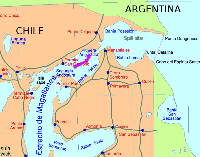52°30′00″S 69°39′00″W / 52.500°S 69.650°W

The VLCC Metula was in a supertanker that was involved in an oil spill in Tierra del Fuego, Chile in 1974. The ship was a Very Large Crude Carrier (VLCC), with a length of 1,067 feet (325 m), draft of 62 feet (19 m) and a deadweight ton capacity of 206,000. It was the first VLCC supertanker to be involved in a major oil spill.[1]
The Metula was sailing from Ras Tanura in Saudi Arabia with a load of over 196,000 tons of light Arabian crude oil destined for delivery to the Chilean National Oil Company (ENAP) at Quintero, Chile.
On the evening of August 9, 1974, the tanker was passing through the First Narrows area, which is over three and half kilometers wide, of the Strait of Magellan, during severe tidal and current conditions. The Metula cut a corner too sharp, hitting a 40-foot shoal and grounding itself. The difficulty of navigating a ship of such size, with minimum navigation aids, contributed to the accident.
On the second day after the grounding, the Metula swung to starboard, holing and flooding its engine room compartments. The U.S. Coast Guard, at the request of the Chilean government played a role in removing the cargo from the ship.
The tanker released about 47,000 tonnes of Arabian light crude oil and between 3,000 and 4,000 tonnes of heavy fuel oil. The rough sea conditions resulted in the formation of a water-in-oil emulsion, which then landed on the shores of Tierra del Fuego.
The Metula was refloated on September 25, 1974, and was laid up and scrapped at Santander, Spain in June 1976. (source http://www.aukevisser.nl/supertankers/VLCC%20L-M/id94.htm)
No cleanup operation was executed due to the remoteness of the area; on many shorelines, the oil formed hard asphalt pavements. One marsh received thick deposits of mousse, which were still visible two decades after the disaster. By 1998, most of the oil deposits had broken up, though asphalt pavement remained in a relatively sheltered area, making it among the longest-term contamination recorded for an oil spill.
- ^ "Weather hampers oil spill cleanup". The Odessa American. 1974-09-22. p. 60. Retrieved 2020-07-02 – via Newspapers.com.